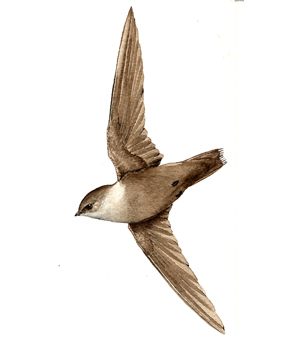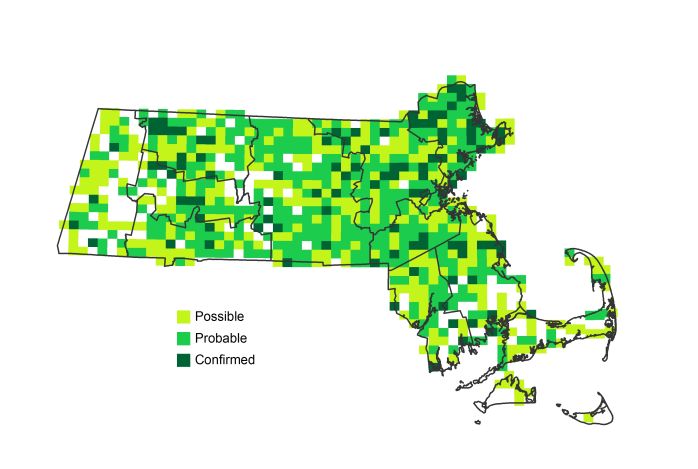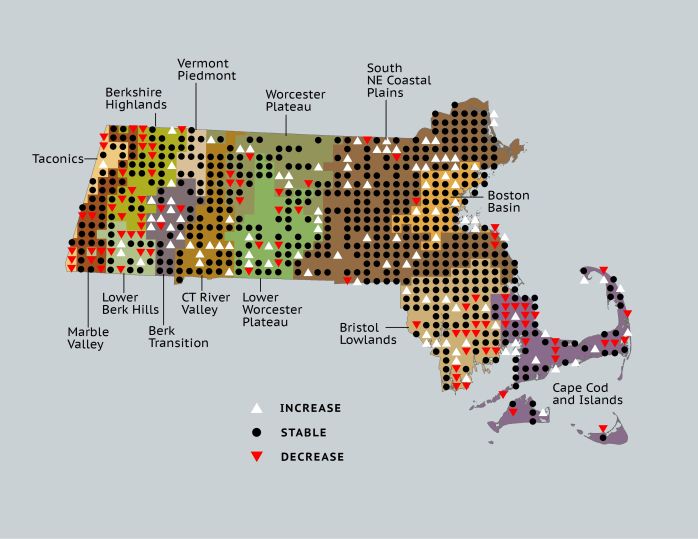Find a Bird
Chimney Swift
Chaetura pelagica

Very widespread and stable
Action/monitoring needed
“At the first glimpse of daybreak, all are in motion, and they pour out in a rushing volume, as if the chimney were bursting out with flames; for a moment it trembles to its foundation; but the swallows disperse to their several cares, and it is left deserted for the day.” – William Peabody, Reports on the Fishes, Reptiles, and Birds of Massachusetts
A twittering series of chip notes and flying cigar-shaped silhouettes in the sky at dusk proclaim the spring return of Chimney Swifts. Their unassuming brown color, fluttery flight, and high-pitched voices have caused them to occasionally be confused with bats, but Chimney Swifts are birds through and through. They are supreme aerobats, living most of their lives on the wing and capturing insects with their broad gapes. Although their historic nesting spots were limited (large hollow trees and occasionally cliffs or caves), the arrival of European colonists ushered in a new era of Chimney Swift abundance. Today, Chimney Swifts are widespread, but may be suffering the same insidious decline seen in other aerial insectivores – a decline yet to be linked to a definitive cause.
Historic Status
It took a long time before Massachusetts residents determined that Chimney Swifts were not, in fact, swallows. In 1839, the Massachusetts Zoological and Botanical Survey (Peabody 1839) reported that the species “formerly, when the country was unsettled, made its nest and place of resort in hollow trees; but having discovered that chimneys have an advantage over those wild tenements, and that a great proportion of them are not in use in the summer, it has now become familiar with man, and abounds in almost all the towns and villages in the country.” As industrialization boomed, so, too, did Chimney Swifts. A horrific tragedy struck the population in 1903 when torrential June rains left bushels of Chimney Swifts dead at the bases of factory chimneys throughout eastern Massachusetts, an event from which they recovered about a decade later (Forbush 1927). Still, their familiarity came with gaps. National Geographic invited assistance in the early twentieth century, by stating, “Any bird lover may secure distinction by solving an ornithological riddle and telling us where our chimney swifts spend the winter. They come in spring, they go in fall and at present that is about all we know of the matter” (Henshaw 1914).
Atlas 1 Distribution
Chimney Swifts were widespread during the Atlas 1 period. The Taconic Mountains had breeding evidence in three-quarters of all blocks, and the Marble Valleys had swifts in every single block. Signs of breeding Chimney Swifts were found in roughly three-quarters of the blocks in each ecoregion, with lowest numbers in the Berkshire Transition, and the Worcester and Lower Worcester Plateaus. Numbers increased through the Coastal Plains and Bristol/Narragansett Lowlands, but the Boston Basin had several notable misses. Cape Cod and the Islands reported less than 50% block occupancy – the only region to do so in Atlas 1, though Chimney Swifts were nonetheless present throughout this zone.
Atlas 2 Distribution and Change
Chimney Swifts were still widely distributed in Atlas 2, although some areas of the state reported declines in breeding activity. The Taconic Mountains and Marble Valleys, both heavily occupied in Atlas 1, lost Chimney Swifts in 10 blocks combined. The decline was even steeper in the Berkshire Highlands, where Chimney Swifts were not found in 15 blocks overall. Similarly, the species was newly absent from 8 blocks overall in the Lower Berkshire Hills. Moving eastward, however, Chimney Swift breeding distribution was stable or even increasing. Gains outstripped losses in the Worcester Plateau regions, and the Connecticut River Valley didn’t lose Chimney Swifts in a single block. Always happy to live alongside humanity, Chimney Swifts also increased their breeding presence in the Coastal Plains and the Boston Basin. The Bristol/Narragansett Lowlands region both gained and lost Chimney Swifts in 15 blocks, but Cape Cod and the Islands posted a negative trend overall. Using our most well covered blocks during Atlas 1 and Atlas 2, overall Chimney Swifts modestly increased and remained stable in 548 blocks, were lost from 92 blocks, and colonized 108 blocks.
Atlas 1 Map

Atlas 2 Map

Atlas Change Map

Ecoregion Data
Atlas 1 | Atlas 2 | Change | ||||||
Ecoregion | # Blocks | % Blocks | % of Range | # Blocks | % Blocks | % of Range | Change in # Blocks | Change in % Blocks |
Taconic Mountains | 12 | 75.0 | 1.7 | 8 | 32.0 | 1.0 | -4 | -26.7 |
Marble Valleys/Housatonic Valley | 39 | 100.0 | 5.5 | 33 | 84.6 | 4.2 | -6 | -15.4 |
Berkshire Highlands | 42 | 76.4 | 5.9 | 31 | 56.4 | 3.9 | -12 | -22.6 |
Lower Berkshire Hills | 21 | 75.0 | 2.9 | 16 | 51.6 | 2.0 | -5 | -18.5 |
Vermont Piedmont | 13 | 76.5 | 1.8 | 17 | 100.0 | 2.1 | 0 | 0.0 |
Berkshire Transition | 23 | 60.5 | 3.2 | 32 | 80.0 | 4.0 | 7 | 22.6 |
Connecticut River Valley | 45 | 80.4 | 6.3 | 58 | 89.2 | 7.3 | 8 | 16.7 |
Worcester Plateau | 52 | 66.7 | 7.3 | 66 | 75.0 | 8.3 | 2 | 4.2 |
Lower Worcester Plateau | 49 | 66.2 | 6.9 | 59 | 73.8 | 7.4 | 1 | 1.9 |
S. New England Coastal Plains and Hills | 227 | 84.1 | 31.9 | 269 | 95.1 | 34.0 | 21 | 9.3 |
Boston Basin | 41 | 73.2 | 5.8 | 53 | 94.6 | 6.7 | 11 | 20.0 |
Bristol and Narragansett Lowlands | 82 | 77.4 | 11.5 | 87 | 76.3 | 11.0 | 0 | 0.0 |
Cape Cod and Islands | 66 | 48.5 | 9.3 | 63 | 43.8 | 8.0 | -8 | -6.7 |
Statewide Total | 712 | 73.5 | 100.0 | 792 | 76.4 | 100.0 | 15 | 1.8 |
Notes
The Chimney Swift shows a significant decreasing Breeding Bird Survey (BBS) trend in Massachusetts, the New England/Mid-Atlantic Region, and the Eastern US overall. They fall into our “whispering bird” category – those species with a demonstrated stable or increasing breeding footprint from Atlas 2 data, but also a demonstrated decline in abundance from the BBS. This drives our final assessment that this is a species with a need for further monitoring and conservation actions to identify recovery options, and test recovery strategies.



